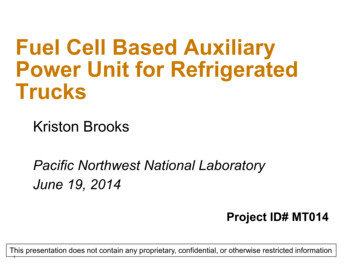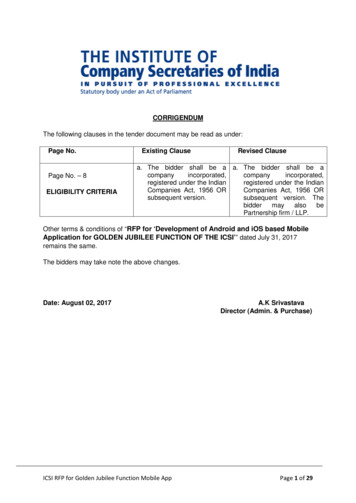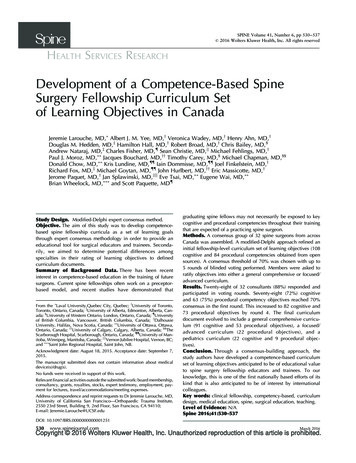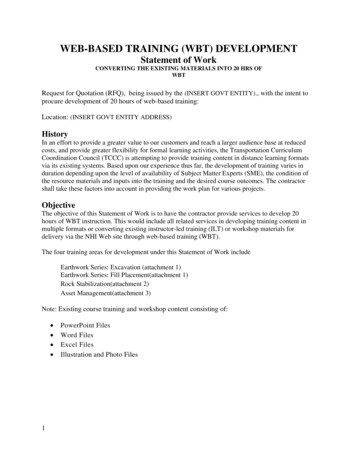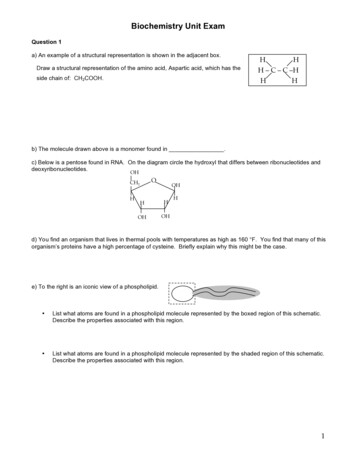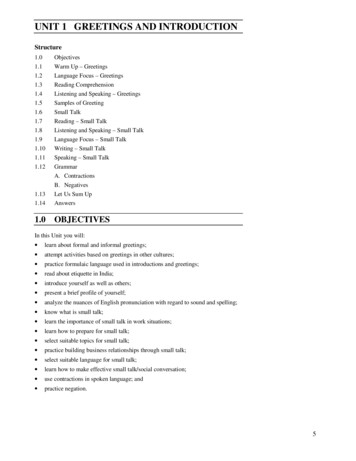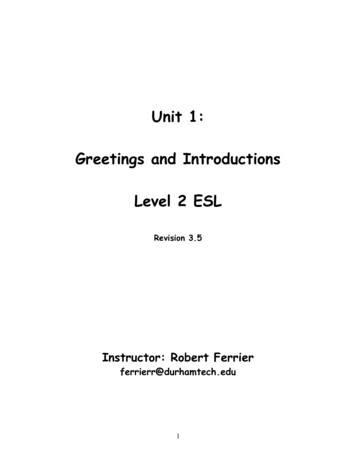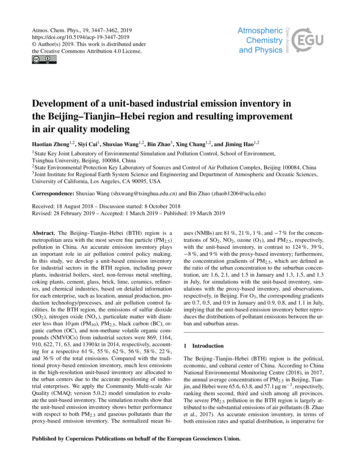
Transcription
Atmos. Chem. Phys., 19, 3447–3462, 2019https://doi.org/10.5194/acp-19-3447-2019 Author(s) 2019. This work is distributed underthe Creative Commons Attribution 4.0 License.Development of a unit-based industrial emission inventory inthe Beijing–Tianjin–Hebei region and resulting improvementin air quality modelingHaotian Zheng1,2 , Siyi Cai1 , Shuxiao Wang1,2 , Bin Zhao3 , Xing Chang1,2 , and Jiming Hao1,21 StateKey Joint Laboratory of Environmental Simulation and Pollution Control, School of Environment,Tsinghua University, Beijing, 100084, China2 State Environmental Protection Key Laboratory of Sources and Control of Air Pollution Complex, Beijing 100084, China3 Joint Institute for Regional Earth System Science and Engineering and Department of Atmospheric and Oceanic Sciences,University of California, Los Angeles, CA 90095, USACorrespondence: Shuxiao Wang (shxwang@tsinghua.edu.cn) and Bin Zhao (zhaob1206@ucla.edu)Received: 18 August 2018 – Discussion started: 8 October 2018Revised: 28 February 2019 – Accepted: 1 March 2019 – Published: 19 March 2019Abstract. The Beijing–Tianjin–Hebei (BTH) region is ametropolitan area with the most severe fine particle (PM2.5 )pollution in China. An accurate emission inventory playsan important role in air pollution control policy making.In this study, we develop a unit-based emission inventoryfor industrial sectors in the BTH region, including powerplants, industrial boilers, steel, non-ferrous metal smelting,coking plants, cement, glass, brick, lime, ceramics, refineries, and chemical industries, based on detailed informationfor each enterprise, such as location, annual production, production technology/processes, and air pollution control facilities. In the BTH region, the emissions of sulfur dioxide(SO2 ), nitrogen oxide (NOx ), particulate matter with diameter less than 10 µm (PM10 ), PM2.5 , black carbon (BC), organic carbon (OC), and non-methane volatile organic compounds (NMVOCs) from industrial sectors were 869, 1164,910, 622, 71, 63, and 1390 kt in 2014, respectively, accounting for a respective 61 %, 55 %, 62 %, 56 %, 58 %, 22 %,and 36 % of the total emissions. Compared with the traditional proxy-based emission inventory, much less emissionsin the high-resolution unit-based inventory are allocated tothe urban centers due to the accurate positioning of industrial enterprises. We apply the Community Multi-scale AirQuality (CMAQ; version 5.0.2) model simulation to evaluate the unit-based inventory. The simulation results show thatthe unit-based emission inventory shows better performancewith respect to both PM2.5 and gaseous pollutants than theproxy-based emission inventory. The normalized mean bi-ases (NMBs) are 81 %, 21 %, 1 %, and 7 % for the concentrations of SO2 , NO2 , ozone (O3 ), and PM2.5 , respectively,with the unit-based inventory, in contrast to 124 %, 39 %, 8 %, and 9 % with the proxy-based inventory; furthermore,the concentration gradients of PM2.5 , which are defined asthe ratio of the urban concentration to the suburban concentration, are 1.6, 2.1, and 1.5 in January and 1.3, 1.5, and 1.3in July, for simulations with the unit-based inventory, simulations with the proxy-based inventory, and observations,respectively, in Beijing. For O3 , the corresponding gradientsare 0.7, 0.5, and 0.9 in January and 0.9, 0.8, and 1.1 in July,implying that the unit-based emission inventory better reproduces the distributions of pollutant emissions between the urban and suburban areas.1IntroductionThe Beijing–Tianjin–Hebei (BTH) region is the political,economic, and cultural center of China. According to ChinaNational Environmental Monitoring Centre (2018), in 2017,the annual average concentrations of PM2.5 in Beijing, Tianjin, and Hebei were 65.6, 63.8, and 57.1 µg m 3 , respectively,ranking them second, third and sixth among all provinces.The severe PM2.5 pollution in the BTH region is largely attributed to the substantial emissions of air pollutants (B. Zhaoet al., 2017). An accurate emission inventory, in terms ofboth emission rates and spatial distribution, is imperative forPublished by Copernicus Publications on behalf of the European Geosciences Union.
3448H. Zheng et al.: Development of a unit-based industrial emission inventory in the BTH regionan adequate understanding of the sources and the formationmechanism of serious air pollution in this area.The spatial distribution is one of the most uncertaincomponents of emission inventories considering the diversesource categories and complex emission characteristics. Thetraditional method of spatial allocation is to distribute theemissions by administrative region into grids based on spatialproxies such as population, gross domestic product (GDP),road map, land use data, and nighttime lights (Geng et al.,2017; Oda and Maksyutov, 2011; Streets et al., 2003). The results may deviate significantly from the actual spatial distributions of many sources (Zhou and Gurney, 2011), especiallythe power and industrial sources, which contribute over 50 %of the total PM2.5 emissions in China (Zhao et al., 2013a).Due to the stricter air quality regulations and the higher landprices in urban areas, people tend to build factories in suburban areas where the population density and GDP are lower.Zheng et al. (2017) studied the influence of the resolutionof gridded emission inventories and found that there werelarge biases when the inventories were distributed to veryfine resolutions following the traditional proxy-based allocation method. The emission inventory could be significantlyimproved with detailed information regarding point sourcessuch as power plants, steel plants, and cement plants. Thehigh spatial resolution of the inventory may subsequentlyimprove the air quality modeling results and enable a bettersource apportionment of air pollution (Y. Zhao et al., 2017).A number of studies have developed the emission inventory in the BTH region (Li et al., 2017; Wang et al., 2014),whereas others have provided emission estimates for this region as part of national or larger-scale emission inventories(Ohara et al., 2007; Stohl et al., 2015). However, only limited studies have estimated the emissions from individualpoint sources (i.e., a unit-based emission inventory). Zhaoet al. (2008), Chen et al. (2014), and Liu et al. (2015) established unit-based emission inventories of coal-fired powerplants in China. K. Wang et al. (2016) and Wu et al. (2015)developed an emission inventory for the steel industry. Lei etal. (2011) and Chen et al. (2015) established an emission inventory for the cement industry in China. Qi et al. (2017) established an emission inventory in the BTH region in whichpower and major industrial sources were treated as pointsources. These studies usually focused on one or several major industries, and did not cover all industrial sectors in theBTH region. Moreover, these previous studies seldom validated the unit-based emission inventory or evaluated the improvement it brings to air quality simulation.In this study, we developed a unit-based emission inventory of industrial sectors for the BTH region. A three-domainnested simulation by the WRF-CMAQ (Weather Researchand Forecasting–Community Multi-scale Air Quality) modelwas applied to evaluate the emission inventory. In order tostudy the influence of the point sources, we compared thesimulation results of this emission inventory with those of atraditional proxy-based emission inventory.Atmos. Chem. Phys., 19, 3447–3462, 201922.1Materials and methodsHigh-resolution emission inventory for the BTHregionA unit-based method is applied to quantify the emissionsfrom industrial sectors such as power plants, industrial boilers, iron and steel production, non-ferrous metal smelters,coking plants, cement, glass, brick, lime, ceramics, refineries, and chemical industries in 2014. The product yields usedfor estimating emissions of each sector are shown in Table S4in the Supplement. The pollutant emissions from each industrial enterprise are calculated from activity level (energy consumption for power plants and industrial boilers, and productyield for other sectors), the emission factor, and the removalefficiency of control technology, as shown in the followingequation: Ei,j Aj EFi,j 1 ηi,j(1)where Ei,j is emissions of pollutant i from industrial enterprise j , Aj is the activity level of industrial enterprise j ,EFi,j is the uncontrolled emission factor of pollutant i fromindustrial enterprise j , and ηi,j is the removal efficiency ofpollutant i by control technology in enterprise j . ηi,j is determined by the production process and control technology ofthe industrial enterprise. The EFi,j values, which depend onthe production process of the industrial enterprise, are calculated according to the sulfur and ash contents of fuels, e.g.,coal, used in each province (for PM and SO2 ), or obtainedfrom our previous study (Zhao et al., 2013b), for other pollutants.Some industrial sources involve multiple production processes, such as iron and steel production and cement production. Using cement production as an example, emissions arecalculated using the following equation:X Ei,j AKj,m EFi,m 1 ηi,j,mm ACj efi 1 ηi,j (2)where Ei,j values are the emissions of pollutant i from industrial enterprise j , AKj,m is the amount of clinker producedby the clinker burning process m of the enterprise j , EFi,mis the uncontrolled emission factor for pollutant i from theclinker burning process m, ηi,j,m is the removal efficiency ofpollutant i from the clinker burning process m in enterprisej , ACj is the amount of cement produced by enterprise j , efivalues are the uncontrolled emission factors from the clinkerprocessing stage (efi 0 if i is not particulate matter), ηi,jis the removal efficiency of pollutant i in enterprise j . ηi,j,mand ηi,j both depend on the control technology of the industrial enterprise.The production processes represented by the first and second terms of Eq. (2) are frequently performed in differententerprises. For example, for cement production, clinker maywww.atmos-chem-phys.net/19/3447/2019/
H. Zheng et al.: Development of a unit-based industrial emission inventory in the BTH regionbe produced in one enterprise and subsequently processed inanother enterprise, which is very common. For each enterprise, we calculate the emission of each production process.Specifically, the total emission of enterprise j is the sum ofthe emissions of all of the production processes in that enterprise. If processes are divided between multiple enterprises,the emission will be considered in the calculation of the emission of each individual enterprise.In this study, we collected detailed information for allpower and industrial sources except industrial boilers, including latitude/longitude, annual product, production technology/process, and pollution control facilities from a compilation of power industry statistics (China Electricity Council, 2015b), the China Iron and Steel Industry Association(http://www.chinaisa.org.cn, last access: 11 March 2019), theChina Cement Association (http://www.chinacca.org, last access: 11 March 2019), Chinese environmental statistics (collected from provincial environmental protection bureaus),the first national census of pollution sources (National Bureau of Statistics, 2010), and the bulletin of desulfurizationand denitrification facilities from Ministry of Ecology andEnvironment of China (http://www.mee.gov.cn, last access:11 March 2019). These emission sources include 242 powerplants, 333 iron and steel plants, 639 cement plants, 151 nonferrous metal smelters, 211 lime plants, 1222 brick and tileplants, 37 ceramic plants, 42 glass plants, 106 coking plants,21 refinery plants, and 328 chemical plants. The iron and cement sectors are divided into specific industrial processes.For industrial boilers, we obtained the location, fuel useamount, and control technologies of over 8000 industrialboilers in Beijing, Tianjin, and Hebei from Xue et al. (2016),the Tianjin Environmental Protection Bureau, and the HebeiEnvironmental Protection Bureau.Plume rise is caused by the buoyancy effect and momentum rise (Briggs, 1982). Therefore, stack information, including stack height, flue gas temperature, chimney diameter,and flue gas velocity, is essential for plume rise calculation.For power plants, we get the stack height from the “Compilation of Power Industry Statistics” (China Electricity Council,2015b). For the stack height of cement factories, we refer tothe emission standard of air pollutants for the cement industry (Ministry of Environmental Protection of China, 2013).For the stack height of glass, brick, lime, and ceramic industries, we refer to the emission standard of air pollutants forindustrial kilns and furnaces (Ministry of Environmental Protection of China, 1997). For the stack height of non-ferrousmetal smelters, coking plants, refineries, and chemical industries, as well as the flue gas temperature, chimney diameter,and flue gas velocity for all industrial sectors, we refer to thenational information platform of pollutant discharge fault.jsp, last access: 11 March 2019), where very detailed information canbe found regarding plants with pollutant discharge permits.For sources without pollutant discharge permits, we use theparameters of plants with a similar production output or mption. Individual information regarding the stacks isapplied to each production process. The locations of different processes from the same enterprise are usually assumedto be the same.The emission inventory for other sources, including residential sources, transportation, solvent use, and open burning, is developed based on the “top-down method” followingour previous work (Fu et al., 2013; Wang et al., 2014; Zhao etal., 2013b). The method is the same as Eq. (1) except that theem
in air quality modeling Haotian Zheng1,2, Siyi Cai1, Shuxiao Wang1,2 . with the unit-based inventory, in contrast to 124%, 39%, 8%, and 9% with the proxy-based inventory; furthermore, the concentration gradients of PM2:5, which are defined as the ratio of the urban concentration to the suburban concen-tration, are 1.6, 2.1, and 1.5 in January and 1.3, 1.5, and 1.3 in July, for simulations .



